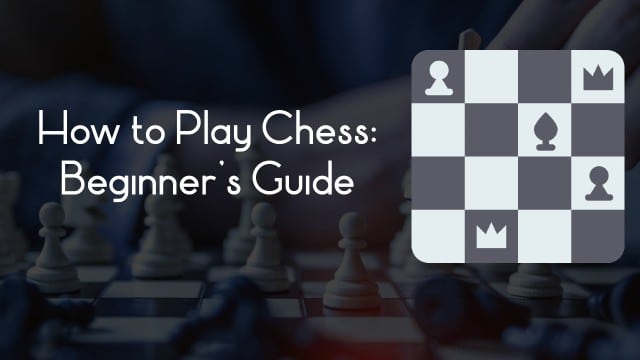How to Play Chess: Beginner’s Guide

Chess is a globally played two-player strategy game that is played on a board. The game is widely thought to be invented in Europe although similar games were already available in India, explaining why some historians point out Asia as the birthplace of the game.
Today, chess is going through a rebirth, which is definitely true for online gambling sites offering chess or variants to the board game in online settings. For New Zealanders who aren’t familiar with the rules or who need a fresh recap, this guide is for you. In our Chess Beginner’s Guide, we will take you through the basics of the board game. After reading this guide we suggest you go ahead and put the theoretical information into practice.
Table of Contents
About Chess
The first time chess was registered in history goes back to ancient India. In the 7th century, a local game called Chaturanga was recorded for the first time in what forms India today. The rules of the game as they are mostly known today were first documented in Europe at the end of the 15th century. It wasn’t until the 19th century before the game was standardised and universally played. Since it was first introduced, chess has seen different modifications, with the main idea of the game being the same as the time it first emerged.
Chess is a board game that is meant for two players competing with each other with white and black pieces. Each player at the table controls an army of chess pieces, with the main goal of the game being to checkmate the opponent’s king. Other than most other games discussed in our how-to-play guides (such as How to Play Texas Hold’em and How To Play Solitaire), chess is an abstract strategy game that doesn’t come with any random elements and thus no factors of chance. This means that skills and practice make a difference. Chess can also be played for real money and is available in online settings.
How To Play Chess Overview |
|
| Goal | The board game has the goal to checkmate the opponent’s king. |
| Origin | India, Europe, 14th/15th century |
| Category | Board game |
| Other Names | International chess |
| Available in New Zealand? | Yes |
Chess Basics
The idea of a game of chess is to capture the opponent’s king. This is also the ultimate objective of chess as a lot of the games will come to an end before this is concluded. This ultimate move is called the checkmate which happens if the player puts the king of the opponent “in check”. This term refers to the king being under threat, unable to move itself or remove the threat. When you get to this ultimate move, make sure to say the word “checkmate” loud and clear. This is the official declaration of the end of the game. After this declaration is made, a double-check needs to be performed by either your opponent or the organisation.
Capturing Pieces
Chess is played on a board and works with 16 pieces per player, together this adds to a total number of 32 pieces that are available on the board. These pieces come in different forms and sizes and are used as a way to attack the opponent by landing on a space with a piece of the other player. When this move is moved, the piece is officially captured after which it is removed from the game. There are different pieces available in the game, but it is important to note that they can’t be placed on the same square of the same colour as these belong to one player. After a piece is captured, the move must be concluded before one’s turn has come to an end. In order to get started it is advised to:
- Familiarise yourself with the rules of the game by paying extra attention to how each piece moves.
- Practise online as there are heaps of free demo games available. There are also real money casino games that let you play against others helping players to develop their skills.
Further on in this guide, we will talk you through the different pieces and how to use them to your benefit. Unlike many other casino games, skills do make a difference in chess.
Setting Up The Board
The game of chess is normally played by two players sitting in front of each other and by making use of a chess board that is shared by the two. This board is divided into segments via 8×8 squares. The total 64 squares in the game change between black and white colours with each colour used by one of the two players; combining both colours is therefore not possible. Once the game board is fully set up and filled in with all the pieces, a white square is found at the rightmost square along the edge of the board.
The pieces come in different sizes and have unique functions. The player’s pieces are set up in the two horizontal rows which can be found closest to each player. The 2nd rank (that is, the 2nd row from the player’s perspective) is made up of a line of 8 pawns, each of them is placed on a single square.
The two squares in the centre of the rank are filled in by the king and queen. The queen is placed on the square matching her colour with the king which is used to occupy the remaining square of the opposite colour. This also means that the king and queen of each colour will face each other. This will be fundamental for the correct setup between the two players as the game is eventually all about the king and the queen. The white player was allowed to take the first move, after which both opponents at the table took turns. These are single turns that go on until one of the players is defeated, although an alternative outcome is a draw when both players do not have a chance anymore to win. Defeat is done via either a checkmate or by resigning. If a timer is used, which tends to be the case in tournaments, the first player to run out of time will end the game. This also means that this player loses and the other is declared the winner of the game.
The Pieces of Chess
As previously mentioned, chess is played on a chessboard with 64 squares in alternating colours, arranged in an 8×8 board. At the start of the game, each player places their 16 pieces: 8 pawns, 2 bishops, 2 bishops, 2 knights, 2 rooks, 1 king, and 1 queen.
- Pawns (1 point): A pawn is only allowed to move one space forward, this can be done towards the side of the opponent. If there isn’t another piece in the way, a pawn is allowed to move 2 spaces forward, this can only be done on the 1st move.
- Knights (3 Points): Knights move in so-called L-shapes which basically means that moves are moved 2 spaces horizontally and 1 space vertically. This can be done either up or down. Knights have a unique feature in comparison with other pieces as they’re allowed to jump over other pieces, making them flexible. For this reason, knights are seen as equally valuable as bishops, both worth 3 points.
- Bishops (3 Points): Speaking of which, the bishops in a game of chess are the thin and tall pieces in the game. They come with what looks like a coin slot carved out at the top of the piece. Bishops are allowed to move in straight lines; this can be done diagonally, in any direction. Unlike knights, they are not allowed to jump over other pieces. Bishops are very useful though for both offence and defence.
- Rooks (5 Points): The rooks are best described as chunky round pieces that remind most Kiwis of a tower on a castle. Rooks are highly useful as they can move any number of squares (both horizontally and vertically). Do note that they are not allowed to jump over other pieces. The two rooks in the game are the most used pieces for making offensive moves, whilst being defensively strong pieces too.
- Queen (9 Points): This is a highly important piece as most players in New Zealand will understand. The queen is the piece that is allowed to move any number of squares in any linear direction as long as there isn’t another piece in the way blocking the path. This basically means that the queen (one available) is allowed to move diagonally, up and down, and left or right. Despite its many roles, a queen is not allowed to jump pieces. The queen is the most useful piece in a game of chess for capturing the king of your opponent whilst protecting your own.
- King (Worth The Game): The king is easily recognised as it’s the tallest piece on the board game. The king is also the most crucial piece that needs to be protected at all times. Kings are allowed to move 1 space at a time in any direction. You can’t move your king into a space where it’s prone to being captured. Or to put it differently, it is not allowed in chess to move your king into check on purpose.
How To Win a Game Of Chess
Like with many board games, all roads lead to Rome, so there are different ways to become victorious in chess. Below, we’ll cover your options of how to win the game:
- Checkmate: This means that the king is in check. In this scenario, the player has no legal move and is completely stuck.
- Resignation: A player is allowed to resign if they see no further moves that can be made. Resigning to chess also means the game is yielded to the opponent. If the opponent has no way of checkmating the player who resigned, this is still considered a draw under the official law for chess. However, most players at tournaments consider it correct to resign if one is stuck in a hopeless position.
- Forfeit: Players who are caught cheating or who break the rules of the game of chess or the rules or etiquettes set at a tournament and previously agreed on, can be excluded from play which means an official defeat.
- Win on Time: Chess games at tournaments that are based on time control will see that the player wins if the opponent runs out of time. Interestingly, this is also true when the other player sees themselves in a much better position. The basic idea behind this is that the player will need a theoretical possibility to checkmate the opponent.
It is also possible that a game of chess comes to an end via what is referred to as an agreed draw. This can happen when a player is left without any legal moves, or if no player at the table can win anymore using available legal moves. This scenario is also referred to as a “dead position”. Furthermore, a game of chess will end in a draw if the same board state is achieved three times. This can happen by mere coincidence although it is very common to do this if none of the players believes that they can win.
Where To Play Chess in New Zealand?
In competitions or tournaments, chess games are usually played with time control adding extra excitement and pressure to the board game. If making use of time control, the game is lost if a player runs out of time which is as harsh as it sounds. This makes chess played at tournaments very different from the chess game as it was once standardised in the 15th century. Chess is also available online and there are also online casinos that offer alternatives to this board game. The game of chess is generally available in the main lobby, although it is normally required to be filtered by category such as “Board Games, “Table Games”, or “Other”. KiwiGambler has the best options for New Zealanders looking for a game of chess as our online partners have often adapted their websites to Kiwis making sure that there are heaps of bonuses and promos available that can be claimed in NZD.








